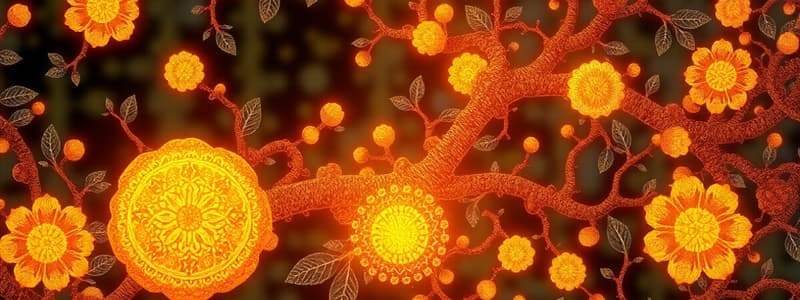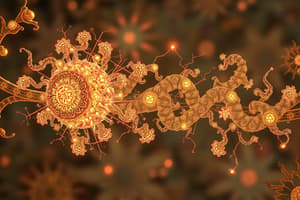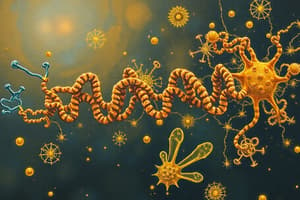Podcast
Questions and Answers
What is produced when NAD+ undergoes reduction in the metabolic reaction involving ethanol?
What is produced when NAD+ undergoes reduction in the metabolic reaction involving ethanol?
- NADH and H+ (correct)
- NADH and acetaldehyde
- FADH and H2O
- NADH and CO2
What type of metabolic reactions requires the coenzyme NAD+?
What type of metabolic reactions requires the coenzyme NAD+?
- Reactions producing nitrogenous bases
- Reactions producing carbon-oxygen double bonds (correct)
- Reactions producing carbon-hydrogen bonds
- Reactions producing amino acids
Which coenzyme is formed when FAD undergoes reduction?
Which coenzyme is formed when FAD undergoes reduction?
- FAD
- FADH
- FADH2 (correct)
- FADH3
In the oxidation of ethanol to ethanal, which enzyme is responsible for the reaction?
In the oxidation of ethanol to ethanal, which enzyme is responsible for the reaction?
What acts as the electron acceptor in the oxidation of alcohols to aldehydes and ketones?
What acts as the electron acceptor in the oxidation of alcohols to aldehydes and ketones?
How many ATP molecules can be hydrolyzed in one second during anabolic processes?
How many ATP molecules can be hydrolyzed in one second during anabolic processes?
What is the maximum amount of ATP hydrolyzed in one day relative to body mass?
What is the maximum amount of ATP hydrolyzed in one day relative to body mass?
Which process provides energy to regenerate ATP in cells?
Which process provides energy to regenerate ATP in cells?
How much energy in kcal/mole is used to make ATP from ADP and Pi?
How much energy in kcal/mole is used to make ATP from ADP and Pi?
What type of reaction is used in the hydrolysis of ATP?
What type of reaction is used in the hydrolysis of ATP?
What is the energy change in kcal/mole when ATP is formed from ADP and Pi?
What is the energy change in kcal/mole when ATP is formed from ADP and Pi?
What role does ATP play in cellular metabolism?
What role does ATP play in cellular metabolism?
What happens during anabolic processes in the context of ATP?
What happens during anabolic processes in the context of ATP?
What happens to FAD during the conversion of succinate to fumarate?
What happens to FAD during the conversion of succinate to fumarate?
What type of coenzyme is involved in the oxidation of succinate?
What type of coenzyme is involved in the oxidation of succinate?
What is the primary function of coenzyme A (CoA) in metabolic reactions?
What is the primary function of coenzyme A (CoA) in metabolic reactions?
During the formation of acetyl CoA, what is the fate of the thiol group in Coenzyme A?
During the formation of acetyl CoA, what is the fate of the thiol group in Coenzyme A?
What is produced when succinate is converted to fumarate in the citric acid cycle?
What is produced when succinate is converted to fumarate in the citric acid cycle?
Which of the following components makes up coenzyme A?
Which of the following components makes up coenzyme A?
In which reaction is coenzyme A not involved?
In which reaction is coenzyme A not involved?
What is the outcome of the addition of an acetyl group to coenzyme A?
What is the outcome of the addition of an acetyl group to coenzyme A?
What is the primary role of NAD+ in the oxidation of glyceraldehyde-3-phosphate?
What is the primary role of NAD+ in the oxidation of glyceraldehyde-3-phosphate?
What is produced when a phosphate group is transferred from 1,3-bisphosphoglycerate to ADP?
What is produced when a phosphate group is transferred from 1,3-bisphosphoglycerate to ADP?
What occurs during the isomerization step of glycolysis involving 3-phosphoglycerate?
What occurs during the isomerization step of glycolysis involving 3-phosphoglycerate?
How many molecules of ATP are produced during the transfer of phosphate from phosphoenolpyruvate to ADP?
How many molecules of ATP are produced during the transfer of phosphate from phosphoenolpyruvate to ADP?
What is the end product of the reaction catalyzed by pyruvate kinase?
What is the end product of the reaction catalyzed by pyruvate kinase?
Which compound is formed through dehydration during glycolysis?
Which compound is formed through dehydration during glycolysis?
What is the significance of the oxidation and phosphorylation reaction involving glyceraldehyde-3-phosphate?
What is the significance of the oxidation and phosphorylation reaction involving glyceraldehyde-3-phosphate?
What type of reaction takes place when 2,3-bisphosphoglycerate is converted into 3-phosphoglycerate?
What type of reaction takes place when 2,3-bisphosphoglycerate is converted into 3-phosphoglycerate?
What happens to pyruvate under aerobic conditions?
What happens to pyruvate under aerobic conditions?
What role does NAD+ play during the oxidation of pyruvate?
What role does NAD+ play during the oxidation of pyruvate?
What is the product formed when pyruvate is oxidized?
What is the product formed when pyruvate is oxidized?
What is produced as a byproduct when pyruvate is oxidized?
What is produced as a byproduct when pyruvate is oxidized?
What is the significance of acetyl CoA in metabolic pathways?
What is the significance of acetyl CoA in metabolic pathways?
Which molecule is involved in the conversion of pyruvate to acetyl CoA?
Which molecule is involved in the conversion of pyruvate to acetyl CoA?
What is the main purpose of the process that converts glucose to pyruvate?
What is the main purpose of the process that converts glucose to pyruvate?
What byproduct is released during the oxidation of pyruvate?
What byproduct is released during the oxidation of pyruvate?
What is the primary function of electron transport in cellular respiration?
What is the primary function of electron transport in cellular respiration?
How many NADH molecules are produced from the complete oxidation of one glucose molecule?
How many NADH molecules are produced from the complete oxidation of one glucose molecule?
In which part of cellular respiration does oxidative phosphorylation primarily occur?
In which part of cellular respiration does oxidative phosphorylation primarily occur?
What is the yield of GTP molecules during the citric acid cycle from one glucose molecule?
What is the yield of GTP molecules during the citric acid cycle from one glucose molecule?
What is the yield of ATP molecules from one glucose molecule through glycolysis?
What is the yield of ATP molecules from one glucose molecule through glycolysis?
Which component of the mitochondria surrounds the matrix?
Which component of the mitochondria surrounds the matrix?
What role do hydrogen ions play during electron transport?
What role do hydrogen ions play during electron transport?
Which of the following processes uses the energy from electron transport to synthesize ATP?
Which of the following processes uses the energy from electron transport to synthesize ATP?
Flashcards
ATP Hydrolysis Rate
ATP Hydrolysis Rate
In active cells, 1 to 2 million ATP molecules are hydrolyzed per second.
ATP Regeneration
ATP Regeneration
Catabolic reactions provide energy to regenerate ATP from ADP and inorganic phosphate (Pi).
ATP Energy Storage
ATP Energy Storage
ATP stores energy used in anabolic reactions.
Energy for ATP Synthesis
Energy for ATP Synthesis
Signup and view all the flashcards
ATP Amount in Cells
ATP Amount in Cells
Signup and view all the flashcards
ATP Production Process
ATP Production Process
Signup and view all the flashcards
ATP Structure
ATP Structure
Signup and view all the flashcards
ATP Role in Anabolism
ATP Role in Anabolism
Signup and view all the flashcards
NAD+ reduction
NAD+ reduction
Signup and view all the flashcards
NAD+ Coenzyme's Role
NAD+ Coenzyme's Role
Signup and view all the flashcards
Ethanol Oxidation
Ethanol Oxidation
Signup and view all the flashcards
FAD coenzyme
FAD coenzyme
Signup and view all the flashcards
FAD Reduction
FAD Reduction
Signup and view all the flashcards
FAD's role in oxidation
FAD's role in oxidation
Signup and view all the flashcards
Succinate to Fumarate
Succinate to Fumarate
Signup and view all the flashcards
Coenzyme A components
Coenzyme A components
Signup and view all the flashcards
Coenzyme A function
Coenzyme A function
Signup and view all the flashcards
Coenzyme A reactive group
Coenzyme A reactive group
Signup and view all the flashcards
Acetyl CoA formation
Acetyl CoA formation
Signup and view all the flashcards
Acetyl group addition
Acetyl group addition
Signup and view all the flashcards
Oxidation or reduction with acetyl group addition
Oxidation or reduction with acetyl group addition
Signup and view all the flashcards
Electron Transport
Electron Transport
Signup and view all the flashcards
Oxidative Phosphorylation
Oxidative Phosphorylation
Signup and view all the flashcards
Mitochondrion
Mitochondrion
Signup and view all the flashcards
Inner Membrane
Inner Membrane
Signup and view all the flashcards
Outer Membrane
Outer Membrane
Signup and view all the flashcards
Intermembrane Space
Intermembrane Space
Signup and view all the flashcards
Matrix
Matrix
Signup and view all the flashcards
ATP Yield
ATP Yield
Signup and view all the flashcards
Glyceraldehyde-3-phosphate Oxidation
Glyceraldehyde-3-phosphate Oxidation
Signup and view all the flashcards
What is the role of NAD+ in glycolysis?
What is the role of NAD+ in glycolysis?
Signup and view all the flashcards
1,3-Bisphosphoglycerate
1,3-Bisphosphoglycerate
Signup and view all the flashcards
Phosphate Transfer in Glycolysis
Phosphate Transfer in Glycolysis
Signup and view all the flashcards
Isomerization in Glycolysis
Isomerization in Glycolysis
Signup and view all the flashcards
Dehydration in Glycolysis
Dehydration in Glycolysis
Signup and view all the flashcards
Phosphoenolpyruvate
Phosphoenolpyruvate
Signup and view all the flashcards
Final Phosphate Transfer
Final Phosphate Transfer
Signup and view all the flashcards
Pyruvate's Fate in Aerobic Conditions
Pyruvate's Fate in Aerobic Conditions
Signup and view all the flashcards
Pyruvate Oxidation
Pyruvate Oxidation
Signup and view all the flashcards
Acetyl CoA: Important Intermediate
Acetyl CoA: Important Intermediate
Signup and view all the flashcards
Glucose Degradation in Glycolysis
Glucose Degradation in Glycolysis
Signup and view all the flashcards
Role of Oxygen in Cell Respiration
Role of Oxygen in Cell Respiration
Signup and view all the flashcards
Aerobic vs. Anaerobic Respiration
Aerobic vs. Anaerobic Respiration
Signup and view all the flashcards
Study Notes
Introduction to General, Organic, and Biological Chemistry
- This book introduces general, organic, and biological chemistry.
Studying That Suits You
Use AI to generate personalized quizzes and flashcards to suit your learning preferences.




